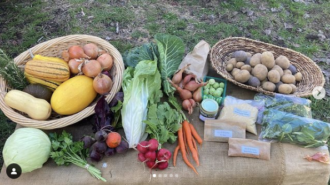For people who grow food and cultivate the land, climate change isn’t something experienced though charts, graphs and predictions of foreboding futures. For growers, the threat of a warming world is immediate and increasing.
“Climate change is playing out on farms like mine every day, every season and in every extreme weather event,” said Caitlin Hachmyer, who owns Red H Farm in Sebastopol, California. “Farmers are nimble and used to working with inclement weather, but the extremes and unpredictability are getting to be too much.”
When Hachmyer founded Red H Farm in 2009, her land was often blanketed by cool, coastal fog. Now, she spends much of her summer dragging hoses from bed to bed beneath hot, dry, smoke-filled skies.
It’s hard on her health, she says, but how can California farmers survive economically without producing crops in the summer and fall? Traditionally, those are the seasons when Western farmers sell their most lucrative fruits and vegetables. Sales of high-value crops like tomatoes are especially important to small, diverse farmers like Hachmyer who grows herbs and vegetables on her one-acre, agroecologically conscious farm.
But Hachmyer has a plan. With help from a $25,000 grant from Western SARE, Hachmyer is transitioning from growing labor-intensive summer crops to vegetables with a longer growing season and more stable shelf life, like beets, onions and winter squash. That way, she can limit her fieldwork when temperatures are high and air quality is low.
Root and other long-season vegetables can be less profitable, but Hachmyer hopes to offset that by selling enough to winter-only Community Supported Agriculture (CSA) subscribers. Most CSA plans are year-around, but Hachmyer is confident the community will support a winter-only bounty of cabbage, broccoli, beets and more.
“We’re excited about the possibilities,” Hachmyer said. “As we shift our growing season, we can expand to include radishes, arugula, lemon balm and lots of other crops. This could be a great way to feed the community while helping farmers adapt to climate change without sacrificing environmental stewardship, economic viability and quality of life.”
As her farm switches from summer to winter crops, Hachmyer will measure how the transition impacts soil health, CSA-member satisfaction, economic viability, and farmer well-being. Hachmyer, who teaches agroecology at Sonoma State University in addition to farming, will share her outcomes with a wide public audience including fellow scientists, educators and farmers.
You can learn more about Hachmyer’s project and how to subscribe to the winter CSA on her website.
“The climate crisis is bearing down on us all,” Hachmyer said. “Hopefully, by working together we can develop solutions to reduce farmer attrition as climate extremes worsen, and protect the health of our communities and our world.”
View Related SARE Grants:
- Assessing the economic and social viability of transitioning to Winter CSA production as an adaptation strategy to climate change impacts (FW22-392)
- Assessing the economic and social viability of transitioning to Winter CSA production as an adaptation strategy to climate change - Seasons 2 and 3 (FW23-433)
